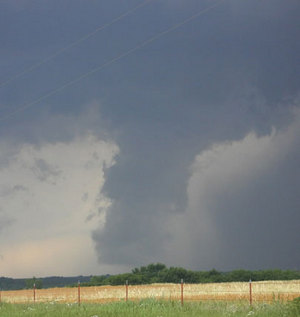
|
| ©Associated Press |
| Clouds descend from a storm that created tornadoes near Marshall, Okla., on Saturday. So far this year, tornadoes have killed 110 people. |
Another week, another train of tornadoes that obliterates entire city blocks, smashes homes to their foundations and kills people even as they take shelter in their basements.
The year is not even half done, but 2008 is already the deadliest tornado year in the United States since 1998 and seems on track to break the U.S. record for the number of tornadoes in a year, the National Weather Service said. Also, this year's storms seem to have been unusually powerful.
Meteorologists cannot explain exactly why this is happening.
Comment: They haven't been reading SoTT
"There are active years and we don't particularly understand why," said research meteorologist Harold Brooks at the National Severe Storms Lab in Norman, Okla.
Over the weekend, an extraordinarily powerful tornado ripped apart Parkersburg, Iowa, destroying 288 houses in the town of about 1,000 residents, said Gov. Chet Culver. At least four people were killed there. Among the buildings destroyed were City Hall, the high school, and the lone grocery store and gas station. Some of those killed were in basements.
The numbers for the United States so far this year: at least 110 dead, 30 killer tornadoes and a preliminary count of 1,191 tornadoes (which, after duplicate sightings are removed, is likely to go down to about 800). The record for the most tornadoes in a year is 1,817 in 2004. In the past 10 years, the average number of tornadoes has been 1,254.
"Right now we're on track to break all previous counts through the end of the year," said Greg Carbin, a warning meteorologist at the Storm Prediction Center, also in Norman.
It's not just more storms. The strongest of those storms - those in the 136-to-200 mph range - have been more prevalent than normal, and lately they seem to be hitting populated areas more, Carbin said. At least 22 tornadoes this year have been in the top part of the new Enhanced Fujita scale, rating an F3 (severe) or an F4 (devastating) on the F1-to-F5 scale.
The tornado that devastated Parkersburg was a F5 - the first in the United States since a 5 tornado nearly obliterated Greensburg, Kan., just over a year ago. The Parkersburg tornado was the strongest in Iowa in 32 years.
Two tornadoes struck the Triad on May 8, an F3 in Clemmons that began as an F2 in Davie County, and an F2 in Greensboro. One person was killed
So far, more than 50 of the deaths this year have been in mobile homes, the wrong place to be during a tornado. They have been a factor in nearly half of all tornado fatalities in recent years.
If that is not bad enough, computer models show that the conditions that form tornadoes are going to stick around Tornado Alley for about another week, Brooks said. The question is why.
Global warming cannot explain what is happening, Carbin said. Although higher temperatures could increase the number of thunderstorms, which are needed to trigger tornadoes, they would also tend to push storm systems too far north for the formation of some tornadoes, he said.
La Niña, the cooling of parts of the central Pacific Ocean that is the flip side of El Niño, was a factor in the increased activity earlier this year - especially in February, a record month for tornado activity - but it cannot explain what is happening now, Carbin said.
He explained the most recent tornadoes with just one word: "May." May is typically the busiest tornado month of the year.
A short-term answer is that the nation's heartland is stuck in a tornado rut with usual temporary weather conditions that can lead to tornadoes parked over the Plains, said Adam Houston, a professor of meteorology at the University of Nebraska-Lincoln. Cooler air at high altitudes and warmer moist air coming from the Gulf of Mexico are combining and settling over the region.
"You get day after day of severe weather and day after day of tornadoes until the pattern changes," Houston said.
But why that happens, Houston does not know. Scientists can forecast hurricane seasons, but predicting their land-bound cousins is much harder, Brooks said. Although tornadoes, like hurricanes, rely on large-scale weather phenomena, the crucial triggers are extremely local weather conditions.
On top of that, tornadoes have a "Goldilocks" issue. To make a tornado, the conditions have to be just right. Too much or too little of one ingredient and there is no tornado. For example, wind shear - when upper and lower winds are at different speeds or coming from different directions - is crucial to create a funnel cloud. Too little, and there is no spin. Too much, and the tornado falls apart.
Tornadoes form most often in late afternoon, between 5 and 9 p.m., so if a thunderstorm starts up early in the morning, it is far less likely to throw off a tornado, Brooks said.
As for why so many people are getting killed, Brooks suggests thinking of the landscape as a dartboard: "We're throwing more darts and throwing bigger darts than normal."
More people are living in mobile homes, and that has shown up in tornado fatality statistics. In 1970, about one-quarter of all tornado deaths were in mobile homes; now it is about half, Brooks said.



Just saying being in a trailor is a bad idea misses the point: modern houses are built no better than a trailor in many instances.